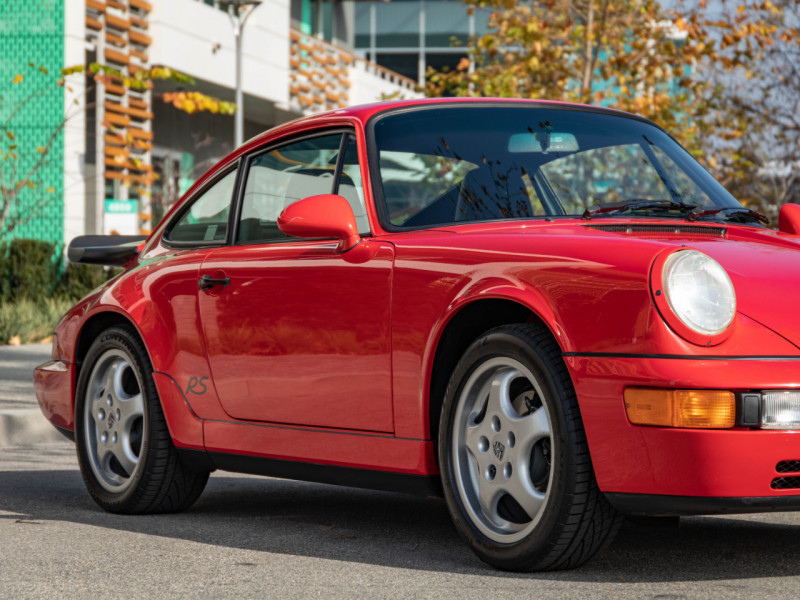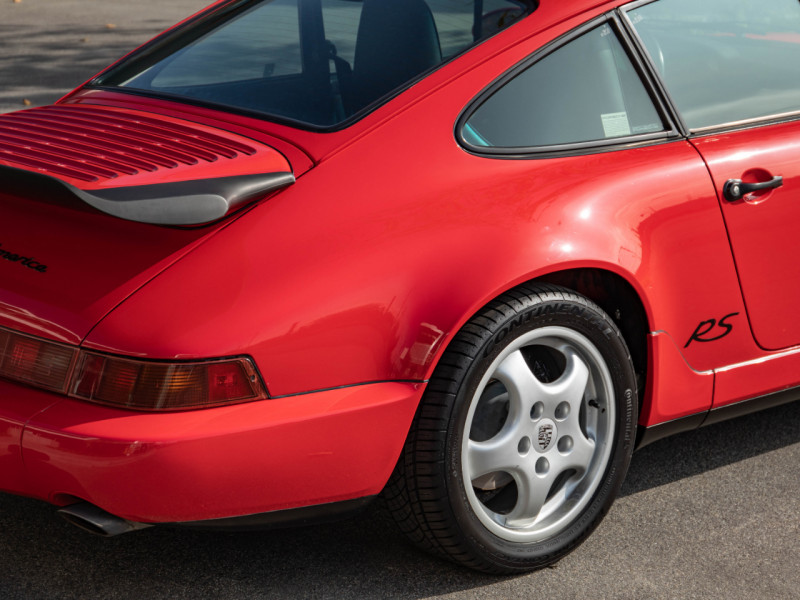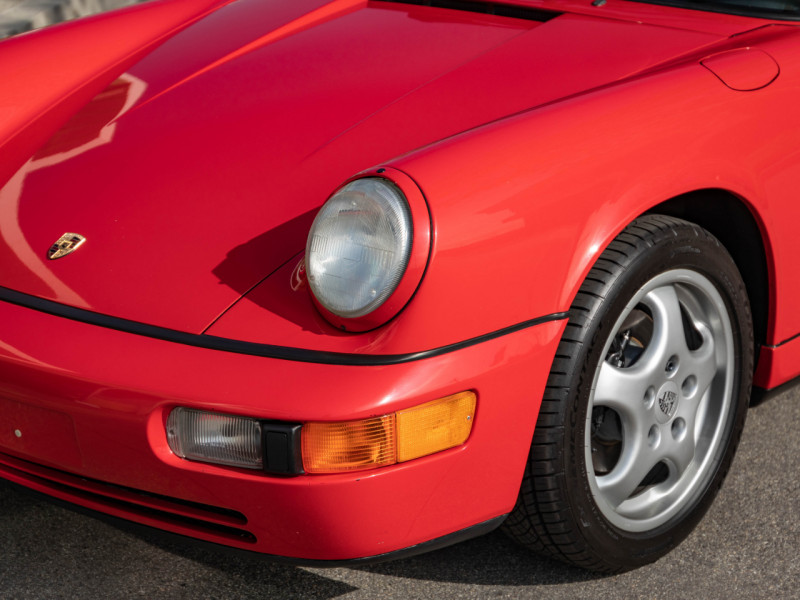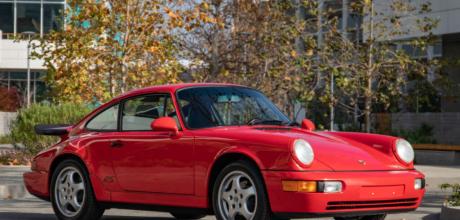Porsche 911 RS America 964
Story of the 964 RS America.Total 911 charts the beginnings of Porsche’s unique 964 Rennsport reserved for the American market.
Written by Kieron Fennelly Photography courtesy Porsche Archive
At the end of the 1960s when California’s new anti-smog legislation became operative, it was apparent that highly tuned cars such as the Porsche 911 would be affected. Breathing through carburettors and running on premium fuel, the 911 was soon in hot water with traffic authorities. The S was even withdrawn for a year in 1969 so that Porsche could reduce its emissions by replacing the Webers with mechanical injection. Yet as the law became tighter this proved to be only a temporary fix and by 1974 the now 2.7 flat six had been converted to K Jetronic injection. This was a second-generation system developed by Bosch for Porsche, which metered out fuel far more carefully and worked with now-mandatory catalytic converters. The timing of American laws meant that Porsche’s largest market wouldn’t have access to the final mechanical injection 911: the celebrated Carrera 2.7 RS. Naturally, this caused dismay, but it would prove to be simply the first of a series of disappointments for US buyers, who would be deprived not just of the 930 Turbo for most of the 1980s, but also the 959. This was a disaster for Porsche because America would have taken probably two-thirds of production, now lost as a result. When reviews of the new 964 RS reached the US in 1991, frustration understandably resurfaced. However, when PCNA (Porsche Cars North America) asked Zuffenhausen to consider homologating the 964 RS, Porsche turned its US subsidiary down. The company claimed that the cost of crash-testing potentially half a dozen cars couldn’t be justified, even against a forecast of 250 cars.

At the time the company was walking a financial tightrope and couldn’t afford to take risks with a 911, which was already registering poor sales in the US because of the collapse of the dollar. In 1991 Zuffenhausen had even begun assembling the Mercedes 500E to make profitable use of redundant production space. This refusal, however, was to reckon without Fred Schwab, PCNA’s ebullient new CEO, and Vic Elford, whom local Porsche enthusiasts enlisted to help. Elford had been living in America since 1984 when he joined Renault Motorsport as US team manager. Naturally, given his fame and competition record, the outgoing Elford was popular with the Porsche community and readily assented to assist representations to Zuffenhausen. Perhaps Elford’s long-standing friendship with Ferdinand Piëch helped, and perhaps the new sales boss at Zuffenhausen, Dieter Laxy, saw an opportunity here, but in any case this would prove to be a successful piece of lobbying. At the Detroit Show in January 1992, a new model appeared on the stand: the Porsche Carrera RS America. Initially,
North American dealers weren’t excited by this seemingly reduced-specification Porsche 911. They recalled the Clubsport that was introduced without fanfare four years earlier and had generated minimal interest. Priced at $46,000 – the same as the standard 3.2 Carrera but without the latter’s air conditioning, sound system or central locking – it seemed to be a car without a purpose. Car & Driver announced that it offered no performance advantage, administering effectively a veritable kiss of death, for eventually a mere 28 Clubsports were sold in the US. However, the RS America was different. Unlike the ill-fated Clubsport which turned up virtually unannounced, not only was the RS America the 911 that enthusiasts had asked for, but wisely, at $53,700 it was priced $10,000 below the 964 Carrera 2. It also resembled the 964 RS, which they had all read about, but knew they couldn’t buy.The February issue of Road & Track described the concept concisely, if somewhat irreverently: “In order to shave 10 grand off the price and about 80lbs off the weight, Zuffenhausen has left off power steering, sound deadening, armrests with built-in cubbies, while including (at no extra cost) sports suspension, oversize wheels and tyres, unique badges and a fixed whale tail spoiler similar to the Turbo’s.”
Bearing in mind it used the same homologation papers and so had to follow much of the specification of the 964 Carrera 2, the RS America turned out altogether superior to the cynical marketing exercise it might have been. Recertifying the model ruled out using much of the Rest of World (RoW) RS specification. The RS America thus had to employ the standard C2 spot-welded shell and window glazing, and steel rather than aluminium boot lid. The RS America was fully undersealed and galvanised, and the flat six was the stock M64/01 rated at 250PS; its dual-mass flywheel, gearbox and ABS brakes came straight from the standard 964 C2. The RS America wasn’t offered in C4 or Tiptronic versions. Inside, the RS America retained the driver and passenger airbags and Porsche’s heavy but comfortable electrically adjustable Sport seats that Above Porsche’s were trimmed in corduroy rather than leather. Combined with the bolsters, the seats gave better lateral support and were more practical than leather in hot climates.

The rear cabin had no seats, and were simply carpeted as the original RS 2.7 had been. Belatedly, the Department of Transport ruled that this space had to be taken up to prevent carriage of a non-seatbelt-wearing passenger, so subsequent RS Americas were delivered with two storage lockers to fill the seat wells. Although retaining the electric windows, the RS America borrowed the simplified door furniture of the RS with its plain door cards and leather pull straps. These straps proved popular and would feature on the subsequent 993 RS and the later GT3s. Door mirrors were manually adjustable, and the RS America used a simplified wiring loom and was fitted with two speakers and an amplifier for the radio – a $986 option. A heated rear window was standard, but not the rear wiper; the standard Porsche alarm system was fitted. The other changes to the standard 964 specification showed Porsche using its parts bin with habitual imagination. The ride height of the RS America had to remain the same as the standard Carrera, but Porsche fitted the firmer coil springs and uprated dampers of the 964 Turbo together with the thicker (22mm) front anti-roll bar. This was effectively the M030 suspension upgrade, a $640 option on the stock Carrera. Wheels were cast 17-inch hollow light alloy Cup (7-inch front and 8-inch rear), again a $1,352 option on the Carrera 2. Not only was the RS America $10,000 cheaper, but it also included $2,000 of options – a point not lost on buyers. The RS America came in three primary colours: Guards red, Black or Grand Prix white. Two metallic shades – Polar silver or Midnight blue – were available as a $1,030 extra. Characteristically, the options catalogue ran to only four items compared with the 48 of the standard 911. Besides the radio, a limited slip differential (40 per cent locking value) was an additional $913, an electrically operated sunroof for $1,952 and air conditioning at $2,805. Though the most expensive, the air-con proved the most popular option and approximately 75 per cent RS Americas were so equipped. Half were specified with radios and/or sunroofs and two-thirds with the LSD. Only 12 cars were ordered with no options at all.
The Cup alloys, the scripted ‘RS’ on the flanks ahead of the rear wheels and the RS America decal on the engine cover served to differentiate the RS America from its more expensive sibling, although the key difference – and the RS America’s trademark – was the fibreglass whale tail spoiler that replaced the 964’s mechanically operated device. Although not a true lightweight by Porsche standards, at 2,954lbs (1,340 kg) the RS America was still some 40kg lighter than the US specification Carrera 2 thanks to the absence of power steering and air conditioning, electric sunroof and its lighter alloy wheels. However, this was enough for PCNA’s marketing department to describe it as “a pure protein Porsche”, going on to say, “Porsche now commemorates the 20th anniversary of the Porsche 911 RS with thecreation of the Porsche 911 RS America. Released in the spring of 1992 as a 1993 model, the RS America is available only in North America. The 1993 RS America captures the spirit of the RS in its emphasis on performance.” Fred Schwab went further, claiming: “If you like autocross, this is your car. If you are a time trialer, you need this car. If driving is for fun, you need this car, the car the PCNA built.” With such a billing, the RS America had much to live up to, especially after the flop of the Clubsport. This time, however, there were few disappointments. Porsche had carefully managed expectations, as this extract from Excellence from August 1992 shows: “For years Americans have heard all about the great Porsches they couldn’t have. If it was a good one, you couldn’t buy it over here. Emissions, laws, crash restraints, you name it, our puritanical heritage insisted on constructing a labyrinth of laws that conspired to keep trick Porsches abroad.”

The article’s author, David Colson, goes on to bemoan the plethora of “tape and paint jobs” that had been offered to Porsche buyers in the US when the rest of the world had the choice of all the “R, RS and RSR versions and their derivatives, but all that was about to change.” This sets the tone for the rest of the article, which goes into raptures about the RS America: that it not only outperformed the standard Carrera, but cost $10,000 less and was, for once, a Porsche RS which North Americans could buy. Indeed, it was even made just for them. Other test reports were similarly enthusiastic. It helped that no one was expecting a replica of the uncompromising European 964 RS. The RS America’s acceleration and top speed were little different from those of the Carrera 2. Road & Track recorded 0-60mph in 5.3 seconds and 0-100mph in 13.0 seconds, in line with factory claims, but Car & Driver recorded 4.6 seconds for 0-60mph. This magazine’s testers were known for their brutal treatment of clutches.
There was general agreement that the RS America’s performance appeared to fall half-way between the stock Carrera 2 and the RoW RS, which they found entirely reasonable. The RS America’s restrained aesthetics also impressed the native scribes, as did the distinguishing whale tail. It was the suspension and steering that really got their ink, not to say blood, flowing. The RS America shared the same clever variable ratio manual steering rack as the RoW (but not UK) RS and combined with the firmer Turbo suspension and wider rims, the result was a noticeably sharper driving experience. Indeed, despite having exactly the same engine as the stock Carrera, the dynamics of the RS America were noticeably more vivid and it just seemed faster. No doubt the absence of sound deadening in the rear bulkhead that Porsche had cannily left out contributed to the enhanced sense of involvement, and it was evident that everyone who sampled the car enjoyed it. Two magazines stated air conditioning ought to have been a standard fitting. Another thought that the limited slip differential should have been part of the package. Yet opinion was that, given its financial and technical constraints, Porsche had produced a 911 worthy of the RS badge.

The public agreed: by October 1992 PCNA was selling equal numbers of the standard 911 Carrera and the RS version. By the time of the final deliveries in May 1994, 701 RS Americas had been sold – three times the forecast that led to the car’s development in the first place. On the other side of the Atlantic, initial reaction was that the RS America was merely a lowspecification Porsche 911 that should never have borne the hallowed initials. But time has changed perspectives: RS America clearly fits the “less is more” approach and it’s also possible to discern the genesis of the successful GTS category that would surface on the run-out 997. Conceived with little room for manoeuvre, the RS America turned out to be a crisp-handling 911 in the lightweight Porsche idiom. Very desirable today, it enjoys a significant following and examples that have not been overcustomised have long changed hands for well over twice the price of a comparable C2.


